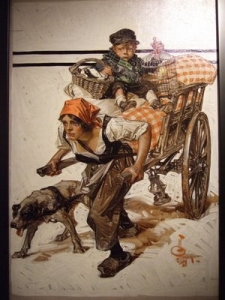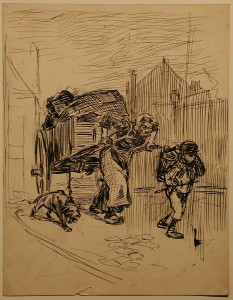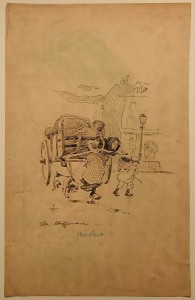
J. C. Leyendecker (1874-1951)|Refugees from The Marne|Cover illustration for The Saturday Evening Post (October 26, 1918), in reference to a story by Edith Wharton|Owner unknown (If anyone has a better digital image, I hope you will share it with me.)
After 1906, the American writer Edith Wharton (1862-1937) spent most of her time living in Paris. During World War I, Wharton made visits to military hospitals and the front lines, writing reports of her experiences for American newspapers. After the war she created her 1918 novella The Marne, a story of a young American boy who witnessed the refugees fleeing from the first battle of the Marne, through his own unexpected participation in the second battle of the Marne. It details his frustration with America’s slowness to help France during the war. J. C. Leyendecker’s Saturday Evening Post cover image for the issue where the story is told is taken from the Wharton’s description of the refugees coming into Paris:
. . . every day the once empty vistas were filled with trains of farm wagons, drawn by slow country horses, and heaped with furniture and household utensils; and beside the carts walked lines of haggard people, old men and women with vacant faces, mothers hugging hungry babies, and children limping after them with heavy bundles. The fugitives of the Marne were pouring into Paris.*
Leyendecker’s illustration of the mother and her dog pulling the filled farm cart with her boy perched on top is compelling. But what interests me most is the fact that the Delaware Art Museum owns two study sketches for this painting. While we are familiar with Leyendecker’s habit of painting a variety of color study vignettes on a single canvas in advance of the finished cover illustration, it is unusual to see study drawings that precede the finished product. Their existence helps to reveal Leyendecker’s process of constructing a composition.

J. C. Leyendecker (1874-1951)|Study drawing for “The Marne”|For cover illustration for The Saturday Evening Post (October 26, 1918)|Ink on paper|In the collection of the Delaware Art Museum, Gifts of Helen Farr Sloan
The first drawing is sketched with a light hand. The image shows a woman and her dog pulling a work cart through city streets, beside her walks a boy carrying a basket on his back. A carriage lamp hangs under the cart. The second drawing is deftly rendered in darker ink lines. There is no carriage lamp in this second sketch, and the sweet dog taking a stroll of the first image has been transformed into a tougher looking wolf-like breed dog who strains against his lead just as the mother strains against her shoulder harness to pull the cart. The child is larger, in front of the mother and cart and appears older.
The mother’s farm origins are revealed in her garb, from the kerchief meant to keep her hair neat, to the wooden sabot she wears on her feet. Wooden shoes were practical attire for farm workers who traipsed through damp fields; besides they wore out more slowly than the more delicate shoe leather. In the sketches the mother is clothed in a dark long-sleeved top, but in the final painting she wears a vest over her loosely laced shift. The boy in all the versions wears leather shoes. In the final published image he is perched on top of the packed cart holding a hand basket in one hand and a bird in a cage in the other. In the first sketch the boy seems young, in the second he appears to be slightly older, and for the final cover, Leyendecker reverted to the younger child. The boy remains in short pants in all three versions, but his cap and over coat are transformed again and again.
The finished cover painting reverses the direction of the group’s movement. The dog is not only a different species, but in the final form he is attached to the cart by a halter rather than a collar. Its breed shifts from a bull-dog type, to wolf-like form and finally into a terrier-type. Also in the final painting, the carriage lamp again swings as it hangs under the cart. Despite the lack of notations of a cityscape and cobbled streets, the final cover painting is stronger than the study drawings. Leyendecker details the shadow cast by this family of refugees as they move through space, implying the rest of the unseen world and grounding the action. Because we view the woman carting her belongings from slightly above the scene, we feel more a part of the weighted action than if we were simply viewing an image as a picture with daily life visible in the background as it is conveyed in the first sketch.
* Edith Wharton, The Marne (New York: D. Appleton and Co., 1918; Philadelphia: The Curtis Publishing Co., 1918): 19.
January 28, 2010
By Joyce K. Schiller, Curator, Rockwell Center for American Visual Studies
Norman Rockwell Museum







